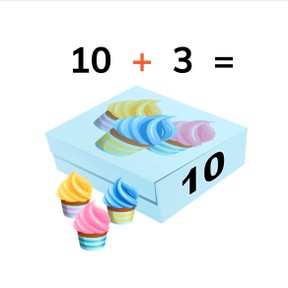



8,000 schools use Gynzy
92,000 teachers use Gynzy
1,600,000 students use Gynzy
General
Students learn to add to 20 using tens and ones.
Introduction
Start by completing three number sequences on the interactive whiteboard. This helps repeat counting forwards and backward to 20. Next, do a counting exercise, counting chocolates. Ask students how they counted. A student might mention that it is easy to count ten, and then count on from there.
Instruction
Tell students that a ten is equal to a group of 10 chocolates. A one is equal to one chocolate. Tell students that if you add the ones to the tens you can add quicker than when you count all of the chocolates separately. Add the ones to the tens, 10 + 3 = 13. You see a box of 10 chocolates and a few loose chocolates. Together with the students, determine what the addition problem is. Then repeat the explanation of what tens and ones are, using blocks. Use the blocks to determine the addition problem given. You can also have students practice with actual blocks.
Next, explain how fill-in-the-blank problems work- that they are missing either the tens or the ones, they must be filled in. Look at the total and then come up with the missing number. Practice this by doing two more of these exercises as a class. Next, repeat fill-in-the-blank problems, but without visual support. State that students should think of the tens first, and then add the loose ones to the tens.
Check that students can add to 20 using tens and ones by asking the following questions:
- How many ones does 14 have?
- How many blocks are in a ten?
- What is 10 plus 6?
- What is 10 + 9?
Quiz
Students first practice completing fill-in-the-blank problems with visual support. Then they must calculate the total of a problem, with visual support. Finally, they must complete an addition problem without visual support wherein they must add the tens.
Closing
Repeat the terms tens and ones and make sure that students understand them. Ask why it is useful to be able to add from 10, using tens. It is useful and fast. To close, do a few fill-in-the-blank problems with the students. First, they must fill in the ones, then the tens, then the total, and finally they must determine the entire problem. They have visual support for this process. These are then repeated in abstract form.
Teaching tips
Make sure to repeat the terms tens (a group of 10) and ones (single loose blocks). Students who have difficulty can be supported by using MAB blocks or other manipulatives to represent the addition problems. Have them set down blocks for the problems, with a set of 10 and 3 loose blocks. Tell students that they don't need to count the blocks that make up the set of 10 because they know that that set has 10 blocks. This speeds up adding.
Instruction materials
Optional: MAB-blocks or manipulatives
The online teaching platform for interactive whiteboards and displays in schools
Save time building lessons
Manage the classroom more efficiently
Increase student engagement
Discover more!
About Gynzy
Gynzy is an online teaching platform for interactive whiteboards and displays in schools.
With a focus on elementary education, Gynzy’s Whiteboard, digital tools, and activities make it easy for teachers to save time building lessons, increase student engagement, and make classroom management more efficient.



